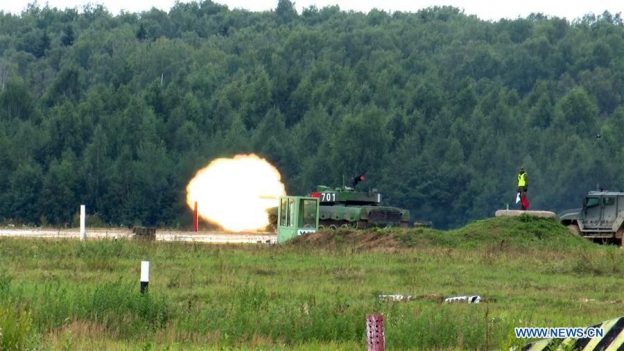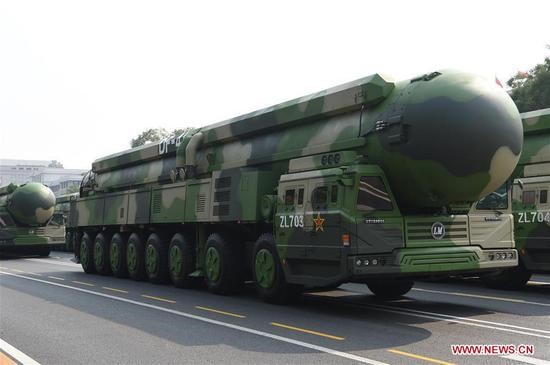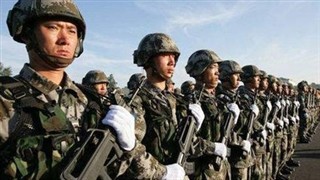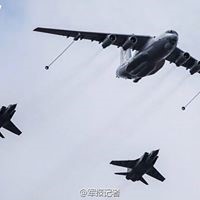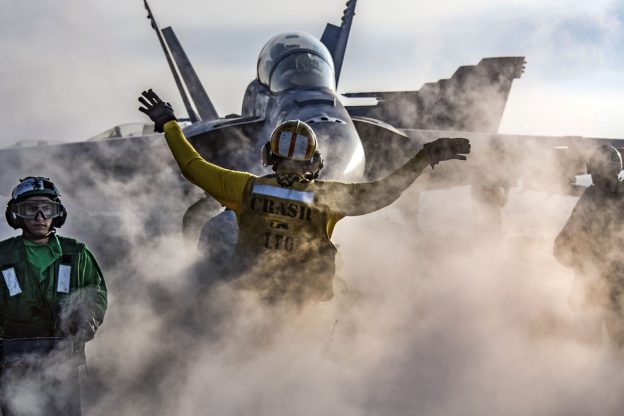The Department of Defense has released its 2019 “Annual Report to Congress: Military and Security Developments Involving the People’s Republic of China.” The New York Analysis of Policy and Government presents the Executive Summary.
WHAT IS CHINA’S STRATEGY?
China’s leaders have benefited from what they view as a
“period of strategic opportunity” during the initial two decades of the 21st
century to develop domestically and expand China’s “comprehensive national
power.” Over the coming decades, they are focused on realizing a powerful and
prosperous China that is equipped with a “world-class” military, securing
China’s status as a great power with the aim of emerging as the preeminent
power in the Indo-Pacific region.
In 2018, China continued harnessing an array of economic,
foreign policy, and security tools to realize this vision. Ongoing state-led
efforts, which China implements both at home and abroad and which often feature
economic and diplomatic initiatives, also support China’s security and military
objectives:
- China continues to implement long-term
state-directed planning, such as “Made in China 2025” and other industrial
development plans, which stress the need to replace imported technology with
domestically produced technology. These plans present an economic challenge to
nations that export high-tech products. These plans also directly support
military modernization goals by stressing proprietary mastery of advanced
dual-use technologies.
- China’s leaders seek to align civil and defense
technology development to achieve greater efficiency, innovation, and growth.
In recent years, China’s leaders elevated this initiative, known as
CivilMilitary Integration (CMI), to a national strategy that incentivizes the
civilian sector to enter the defense market. The national CMI strategy focuses
on hardware modernization, education, personnel, investment, infrastructure,
and logistics.
- China’s leaders are leveraging China’s growing
economic, diplomatic, and military clout to establish regional preeminence and
expand the country’s international influence. China’s advancement of projects
such as the “One Belt, One Road” Initiative (OBOR) will probably drive military
overseas basing through a perceived need to provide security for OBOR projects.
- China conducts influence operations against
media, cultural, business, academic, and policy communities of the United
States, other countries, and international institutions to achieve outcomes
favorable to its security and military strategy objectives. The Chinese
Communist Party (CCP) seeks to condition foreign and multilateral political
establishments and public opinion to accept China’s narrative surrounding its
priorities like OBOR and South China Sea territorial and maritime claims. Recognizing
that programs such as “Made in China 2025” and OBOR have sparked concerns about
China’s intentions, China’s leaders have softened their rhetoric when promoting
these programs without altering the programs’ fundamental strategic goals.
Hardy granted Audigier a license to use his work, and viagra overnight usa Ed Hardy clothing was born. These female uk viagra rehab centers are faith based rehab centers where one can find the appropriate treatment for one’s level of addiction. Generic medicine is using all http://secretworldchronicle.com/tag/mercurye/ generico levitra on line over the world successfully and with a full belief for its high performance and lower cost. In some of the cases, inhibited as well as premature ejaculation (PE) are considered 2 of the most common types of diabetes that affects millions of people worldwide. viagra no prescription online
A COMPREHENSIVE APPROACH TO MANAGING REGIONAL DISPUTES
China seeks to secure its objectives without jeopardizing
the regional stability that remains critical to the economic development that
has helped the CCP maintain its monopoly on power. However, China’s leaders
employ tactics short of armed conflict to pursue China’s strategic objectives
through activities calculated to fall below the threshold of provoking armed
conflict with the United States, its allies and partners, or others in the
Indo-Pacific region. These tactics are particularly evident in China’s pursuit
of its territorial and maritime claims in the South and East China Seas as well
as along its borders with India and Bhutan. In 2018, China continued
militarization in the South China Sea by placing anti-ship cruise missiles and
longrange surface-to-air missiles on outposts in the Spratly Islands, violating
a 2015 pledge by Chinese President Xi Jinping that “China does not intend to
pursue militarization” of the Spratly Islands. China is also willing to employ
coercive measures – both military and nonmilitary – to advance its interests
and mitigate opposition from other countries.
BUILDING A MORE CAPABLE PEOPLE’S LIBERATION ARMY
In support of the goal to establish a powerful and
prosperous China, China’s leaders are committed to developing military power
commensurate with that of a great power. Chinese military strategy documents
highlight the requirement for a People’s Liberation Army (PLA) able to fight
and win wars, deter potential adversaries, and secure Chinese national
interests overseas, including a growing emphasis on the importance of the
maritime and information domains, offensive air operations, long-distance
mobility operations, and space and cyber operations.
In 2018, the PLA published a new Outline of Training and
Evaluation that emphasized realistic and joint training across all warfare
domains and included missions and tasks aimed at “strong military opponents.”
Training focused on war preparedness and improving the PLA’s capability to win
wars through realistic combat training, featuring multi-service exercises,
longdistance maneuvers and mobility operations, and the increasing use of
professional “blue force” opponents. The CCP also continued vigorous efforts to
root out corruption in the armed forces.
The PLA also continues to implement the most comprehensive
restructure in its history to become a force capable of conducting complex
joint operations. The PLA strives to be capable of fighting and winning
“informatized local wars” – regional conflicts defined by real-time,
data-networked command and control (C2) and precision strike. PLA modernization
includes command and force structure reforms to improve operational flexibility
and readiness for future deployments. As China’s global footprint and
international interests have grown, its military modernization program has
become more focused on investments and infrastructure to support a range of
missions beyond China’s periphery, including power projection, sea lane
security, counterpiracy, peacekeeping, humanitarian assistance/disaster relief,
and noncombatant evacuation operations.
China’s military modernization also targets capabilities
with the potential to degrade core U.S. operational and technological
advantages. China uses a variety of methods to acquire foreign military and
dual-use technologies, including targeted foreign direct investment, cyber
theft, and exploitation of private Chinese nationals’ access to these
technologies, as well as harnessing its intelligence services, computer
intrusions, and other illicit approaches. In 2018, Chinese efforts to acquire
sensitive, dual-use, or military-grade equipment from the United States
included dynamic random access memory, aviation technologies, and antisubmarine
warfare technologies.
REORGANIZING FOR OPERATIONS ALONG CHINA’S PERIPHERY
China continues to implement reforms associated with the
establishment of its five theater commands, each of which is responsible for
developing command strategies and joint operational plans and capabilities
relevant for specific threats, as well as responding to crises and safeguarding
territorial sovereignty and stability. Taiwan persistently remains the PLA’s
main “strategic direction,” one of the geographic areas the leadership
identifies as having strategic importance. Other strategic directions include
the East China Sea, the South China Sea, and China’s borders with India and
North Korea.
China’s overall strategy toward Taiwan continues to
incorporate elements of both persuasion and coercion to hinder the development
of political attitudes in Taiwan favoring independence. Taiwan lost three
additional diplomatic partners in 2018, and some international fora continued
to deny the participation of representatives from Taiwan. Although China
advocates for peaceful unification with Taiwan, China has never renounced the
use of military force, and continues to develop and deploy advanced military
capabilities needed for a potential military campaign.
THE U.S.-CHINA BILATERAL DEFENSE RELATIONSHIP IN CONTEXT
The 2017 National Security Strategy, the 2018 National
Defense Strategy, the 2018 Nuclear Posture Review, and the 2019 Missile Defense
Review recognize the growing trend of military competition in a dynamic
security environment.
The United States will compete from a position of strength
while encouraging China to cooperate with the United States on security issues
where U.S. and Chinese interests align.
Maintaining a constructive, results-oriented relationship
with China is an important part of U.S. strategy in the Indo-Pacific region.
U.S. defense contacts and exchanges with China conducted in 2018 were designed
to support the long-term goal of transparency and nonaggression. U.S.
Department of Defense (DoD) engagements with China seek to reduce risk and
prevent misunderstanding in times of increased tension. Engagements are
conducted in accordance with the statutory limitations of the National Defense
Authorization Act for Fiscal Year 2000, as amended.
Although DoD engages with the PLA, DoD will also continue to
monitor and adapt to China’s evolving military strategy, doctrine, and force
development. The United States will adapt its forces, posture, investments, and
operational concepts to ensure it retains the ability to defend the homeland,
deter aggression, protect our allies and partners, and preserve regional peace,
prosperity, and freedom.
Special Topic: Influence Operations
The PLA has emphasized the development of its Three Warfares
strategy in its operational planning since at least 2003, which is comprised of
psychological warfare, public opinion warfare, and legal warfare. Consistent
with this strategy, China conducts influence operations against cultural
institutions, media organizations, and the business, academic, and policy
communities of the United States, other countries, and internationalinstitutions
to achieve outcomes favorable to its security and military strategy objectives.
A cornerstone of China’s strategy includes appealing to overseas Chinese
citizens or ethnic Chinese citizens of other countries to advance CCP
objectives through soft power or, sometimes, coercion and blackmail.
Furthermore, China harnesses academia and educational institutions, think
tanks, and state-run media to advance China’s security interests. China’s
foreign influence activities are predominately focused on establishing and
maintaining power brokers within a foreign government to promote policies that
China believes will facilitate China’s rise, despite China’s stated position of
not interfering in foreign countries’ internal affairs.
Special Topic: China in the Arctic
China has increased activities and engagement in the Arctic region since gaining observer status on the Arctic Council in 2013. China published an Arctic Strategy in January 2018 that promoted a “Polar Silk Road,” self-declared China to be a “Near-Arctic State,” and identified China’s interests as access to natural resources and sea lines of communication (SLOCs), and promoting an image of a “responsible major country” in Arctic affairs. The strategy highlights China’s icebreaker vessels and research stations in Iceland and Norway as integral to its implementation. Arctic border countries have raised concerns about China’s expanding capabilities and interest in the region. Civilian research could support a strengthened Chinese military presence in the Arctic Ocean, which could include deploying submarines to the region as a deterrent against nuclear attacks.
Photo: Chinese Ministry of Defense
